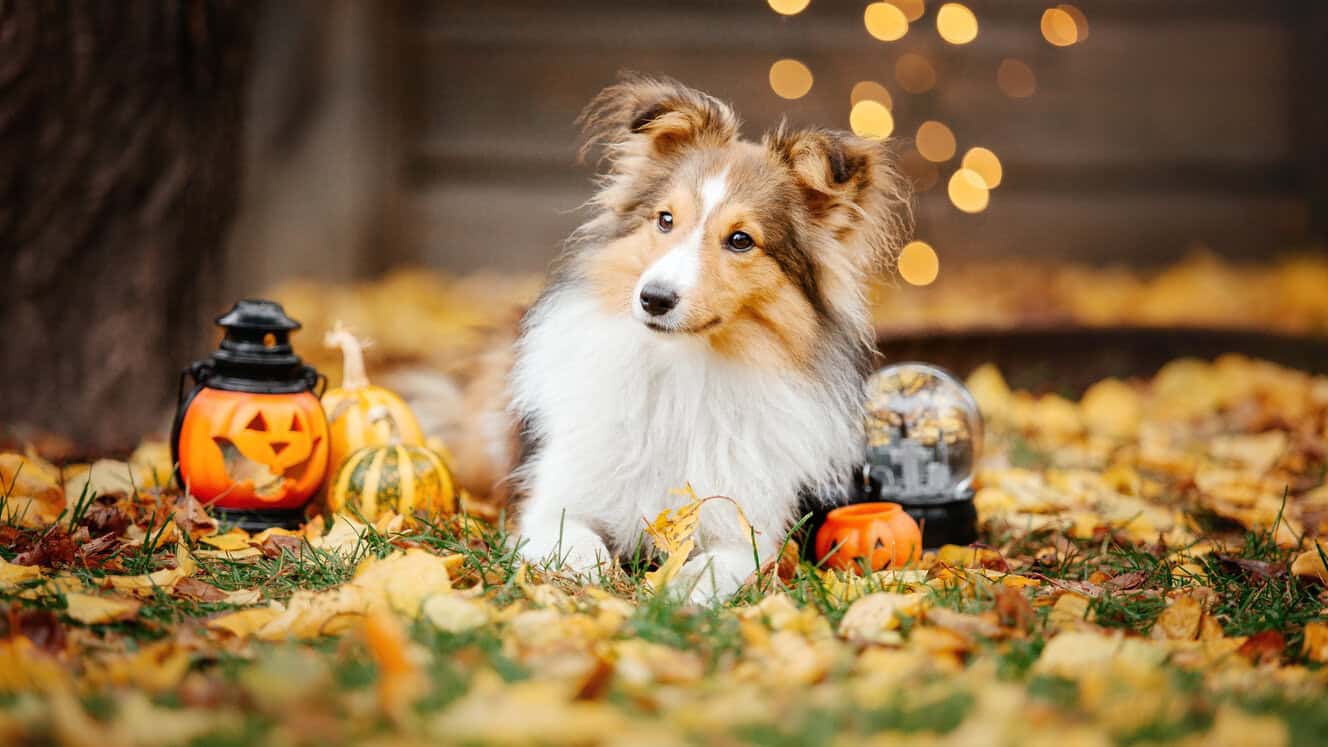

Expert approved
Gruesome, grinning jack-o’-lanterns peeking out of dark windows and overexcited kids wearing ghoulish get-ups, going door to door to grab handfuls of sweets – Halloween is full of spooky fun. The roots of this eerie event stretch back to the ancient Celtic festival of Samhain, when it was believed the boundaries between the living and the dead grew thin – yikes! To ward off wandering spirits, people dressed in costumes and lit bonfires. Today, celebrating Halloween with all the trimmings is more popular than ever.
“Halloween can be one of the best times of the year for humans – from the fancy dress and sweets to spooky decorations and fun events. In recent years, the tradition has been increasing in popularity across the UK – but this has made it trickier for pet owners to navigate. The festivities, decorations and food can all pose hazards to our pets,” says Petplan.
Terrifying trick-or-treaters
“While lots of us will enjoy Halloween, it can be a stressful time for pets,” advises veterinary charity PDSA. With more knocks on the door, people dressed up, and visitors coming into your home, pets could be left feeling unsettled. It’s also a time of the year when there are more human treats and spooky decorations around the house, which could seriously harm our four-legged friends.”
“Even the most easy-going pets can get scared and anxious with a stream of trick-or-treaters coming to the door or into the house,” adds Petplan. “To avoid unnecessary stress for your pet, try to keep them away from the front door and make sure they have a peaceful place to retreat to. Give them a cosy bed or blanket to snuggle up on with undisturbed access to food, water and a litter tray.”
When your feline friend turns into a witch’s cat – does your cat get spooked by Halloween? >>
It pays to plan ahead
“It’s inevitable that your doorbell will be going off more than normal on Halloween night, so plan ahead,” advises animal welfare charity Blue Cross. “Stick to your dog’s routine and pre-empt people knocking by preparing lots of things to keep your dog busy, quiet and happy, like a long-lasting chew or Kong. Separate them from the entrance to your home using a stair gate if this is what would suit them better, and they are used to it.”
The charity also advises that it’s important to reward your dog’s good behaviour, such as calmness, settling, and responding to cues: “Remember that if your dog appears not to be listening to you, this may be because they are worried and reacting to very different experiences to those they are used to on a normal evening. Set them up for success and don’t tell them off. Telling a dog off can make the problem worse.”
How to identify and help a stressed-out pet >>
A few practical steps can go a long way to keeping your pets safe and helping them cope during the spookiest time of year...
Check out PDSA’s Halloween survival guide for pets
- KEEP HALLOWEEN TREATS OUT OF PAWS’ REACH Chocolate is poisonous to pets as it contains a toxic chemical called theobromine. Even a small amount of chocolate can be fatal. Sweets can also be dangerous for pets if they have the sweetener xylitol (birch sugar). As we stock the cupboards with tasty Halloween-themed treats, make sure all sweets and wrappers are kept well away from pets.
- MOVE CANDLE-LIT PUMPKINS AWAY FROM PETS If one of your favourite Halloween traditions is to carve a pumpkin, ensure carving tools and lit candles are well away from furry friends. Candle-lit pumpkins may look spooktacular, but to prevent any curious pets from burning their noses this Halloween, keep them out of paws’ reach. Once the holiday is over, don’t forget to dispose of pumpkins safely to prevent your pet from gobbling gone off or mouldy pumpkins.
- DON’T DRESS UP PETS While we might like to dress up in scary costumes, most pets don’t. Costumes can make pets feel stressed and uncomfortable. Our four-legged friends are adorable just as they are, so our advice would be to steer clear of Halloween costumes for pets. Wearing clothes doesn’t come naturally to pets, and it can cause them stress, especially cats. Stressed cats might groom themselves a lot, be aggressive towards you or make more noise than usual. Dogs might show they’re stressed by licking their lips, yawning or panting.
- HANG HALLOWEEN DECORATIONS OUT OF PETS’ REACH Many cats and dogs love to play with dangly decorations. However, if they get hold of them, they could end up chewing and swallowing something harmful, leading to serious problems such as a gut blockage. Make sure you hang spooky decorations out of pets’ reach.
- LEAVE TREATS FOR TRICK-OR-TREATERS OUTSIDE Knocks on the door and unfamiliar people approaching your house can make some pets feel anxious, especially if they’re not used to visitors. This Halloween, why not place a ‘help yourself’ bucket filled with sweet treats outside your front door or at the bottom of your drive? That way, trick-or-treaters can help themselves to sweets without unsettling your pet.
- BE HOME BEFORE DARK To avoid stress in dogs, take them for walkies before it goes dark. Trick-or-treaters in costume and loud music from parties can be scary for our pets, so it’s best to be at home with them before Halloween activities start. For cats, encourage them to come home earlier by moving their dinner time to before it gets dark outside. And make sure you have beds and litter trays if you’re shutting the cat flap for the evening. Close the curtains and windows if there’s lots of noise outside. If your pet seems worried or anxious, it might be better to avoid going out and leaving them alone. Instead, why not snuggle up for a spooky movie night with them instead?
Fending off firework frights
Spooky season also means the arrival of fireworks, which can be totally terrifying for animals. According to the PDSA Animal Welbeing (PAW) Report, 41% of dog owners said that their dog is afraid of fireworks – that’s 4.1 million dogs across the UK! Previous data also revealed that the same fear was, unsurprisingly, affecting other pet animals – 34% of cats and 18% of rabbits.
Off with a bang? How to help your pets overcome noise phobias >>
“While the loud whizzes, bangs and whistles of rockets, Roman candles and sparklers can be fun for some, fireworks displays can be extremely traumatic for animals. Sadly, each year, vets treat animals with injuries as a result of stress and fright, as well as burns,” says the British Veterinary Association (BVA). “As the countdown to fireworks season begins, it’s good to start preparing now to keep animals safe. If your pet gets significantly distressed by fireworks, ask your vet about longer-term treatment options.”
BVA’s top tips for pet owners as firework season approaches
- Talk to your vet to discuss treatment options for fireworks-induced stress. This may include drugs to help dogs with noise phobias or pheromone products to apply next to your pets’ den and around the house to keep them calm.
- Create a well-padded den for your pet to access ahead of fireworks season so they have a safe place to hide when fireworks start.
- Ensure your pet is microchipped and your details are up to date on the database, in case it runs away from home.
- Move small pets such as rabbits and guinea pigs to a quiet place.
- Close windows and curtains and provide background noise to help mask the fireworks.
- If your pet is distressed, remain calm yourself. Restlessness or toileting in the house can be signs of stress, so don’t punish them.
8 ways to make firework season less scary for your pets >>
Practical ways to help your pets feel calm and safe
This time of year, our pets need us to help them cope with all the strange sights and scary noises. Pet rehoming charity Woodgreen has lots of useful tips.
How to manage a frightened dog
- Have a place for your dog to hide.
- If your dog comes out to you, praise them for being brave.
- If your dog comes to you for reassurance, keep your voice calm. It’s OK to be affectionate and soothe them.
- Make sure your dog is tired from a good walk and a meal.
- Close the curtains and put the radio or TV on for background noise.
- Give your dog a special treat or favourite chew to keep them busy.
- If your dog is displaying mild anxiety, distract them with a play or training session.
- Get a supplement to help your dog from your vet: ADAPTIL plug-ins or collars are best if used two weeks before the night. Anaxitane Chewable Tablets help pets keep calm and relaxed. Calmex is a calming supplement that helps maintain a normal disposition.
- Tune into Woodgreen’s Spotify calming playlist, featuring over an hours’ worth of classical music to help sooth your pets during firework season.
How to manage a frightened cat
- If your cat has access to an outdoor space, keep them in when it gets dark.
- Close your curtains to shut out any light flashes.
- Play music or put the television on to help mask the sound of fireworks.
- Give your cat plenty of personal space. Allow them to hide if they wish and come out in their own time. Trying to comfort them or pulling them from their hiding place may cause more stress.
- If they choose to stay in the same room as you, gently talk to them for reassurance. They may find a familiar voice soothing at this time.
- Provide your cat with tasty food or treats. Although their appetite may be low, some cats will like to have a positive treat to help distract them from the noises.
- Make sure your cat has lots of hiding places around the house. That way they’ll have a choice of safe places to retreat to.
- Provide an indoor litter tray in a quiet location, close to places your cat can hide. Bear in mind, anxious cats often avoid toilet visits if they feel threatened.
- Use products such as Feliway or Pet Remedy to help reduce stress. It’s best to start using them a few weeks before fireworks are expected.
How to manage frightened small pets
It may be tempting to move your small outdoor pets like rabbits, guinea pigs and ferrets inside when firework displays are on. Some may benefit a move into a shed or garage overnight to protect them from the sights and sounds. However, moving your small pets from their familiar environment can be quite stressful, so it may be better to leave them in their normal space. Woodgreen recommends the following to help them with firework season:
- Add extra hiding spaces and bedding to their accommodation.
- Lock away outdoor pets in their night accommodation slightly earlier than normal to allow them to settle before the fireworks start.
- Partially cover hutches and enclosures with thick blankets. This will help muffle the sound of fireworks, whilst also providing enough ventilation.
- For small pets living indoors, close the curtains and put a radio on for some background noise.
- Provide them with their favourite healthy treats to encourage foraging, which will help them focus. This could include hay kebabs, paper rummage bags, stuffed toilet rolls, feed balls and activity treat boards. Winter Berry Bakes are a super seasonal treat!
- Avoid too much handling, as this can cause more fear and stress.
- Companionship is the biggest protector against fear for most small pets (other than hamsters). A pair or group of the same species are far more likely to remain in a relaxed state as their companions offer security and comfort.
Wonderful ways with hay – did you know, hay can make your small pets happy? >>
So, here’s to a Happy Halloween and a chilled-out Bonfire Night for pets everywhere!
LOVE PETS? TRUST BURGESS – WE’RE EXPERTS IN OUR FIELD!
Burgess Pet Care is one of the UK's leading pet food manufacturers for the country’s most popular pets – dogs, cats, rabbits, guinea pigs, chinchillas and degus, hamsters, gerbils and mice, rats and ferrets.
At Burgess Pet Care, all our high-quality recipes have been formulated by vets and nutritionists. This ensures they contain the right balance of vitamins and minerals to help keep them happy and healthy. With a long tradition of supporting British farmers, we actively source all our ingredients as close to our mill as possible.
For helpful feeding advice, call our expert team on 0800 413 969. They’re available 9am-5pm, Monday to Friday. Alternatively, use our online form to get in touch.
CARE MORE Find lots of useful advice on caring for all your pets from Burgess, the pet experts. Training, nutrition, grooming and general care. It's all here >>
Is your dog a Burgess dog? Your cat a Burgess cat? Your small pets Burgess small pets? Join the Burgess Pet Club for exclusive offers, competitions and expert advice from our in-house vet, Dr Suzanne Moyes.
If you found this interesting, you may also like:
AUTUMN HAZARDS From toxic conkers to irritating harvest mites, fungus-filled leaf mould to disease-carrying ticks, not to mention the dangers of antifreeze and rock salt on roads and pavements, make sure you know how to keep your furry best friends safe from harm.
COSY TOES AND SNUGGLY NOSES As the days get shorter and there’s a distinct chill in the air, as well as digging out our woolly socks, bobble hats and fluffy fleeces, it’s time to turn our attention to what our pet friends need to stay healthy and happy during the winter.
WINNING WINTER! Short, frosty days and endless dark nights with not much to do – winter can be tough to get through, whether you’re human or animal. But, with some practical tips and inspiring ideas, you can make winter a fun time of year for your furry friends, giving you a boost too!
STRANGER DANGER For some pets, (dogs, we’re looking at you) the arrival of visitors is generally a positive, tail-wagging, making-a-fuss-of experience. However, for cats, unfamiliar humans entering their territory can send them running for cover. So why is this the case?
BRING ON THE HAY! As autumn steals its way in with misty mornings, tumbling leaves and a distinct nip in the air, your small furries will be hoping for some extra tasty hay to snuggle into and munch on...
BECOME A DOG COMMUNICATION EXPERT Spending more time with your canine chum? It’s the perfect opportunity to learn more about what they’re trying to tell you.
THE CAT COMMUNICATION GUIDE From purrs to scent signals, body postures and blinking, yowls to growls – cats communicate in a variety of ways. Solve the mysteries of cat communication with our guide.
HOW TO TELL IF YOU HAVE A HAPPY PET Wheek-wheeking, bruxing, dooking, chirping, binkying, popcorning – there are all sorts of ways our pets tell us they’re feeling good, once you know what to look for.
FINDING A VET FOR YOUR SMALL PETS Did you know that just like hospital specialists, vets have different areas of expertise? That’s why, if you have small pets, it can be a good idea to seek out a vet that specialises in small animal medicine.
PEEK-A-BOO – HELLO KITTY, I SEE YOU! Even the most confident of cats need some me-time to feel safe and secure and will take themselves off somewhere quiet and private to recharge. That’s why all cats deserve a cosy hideaway to withdraw from the world when they need to.
BIG IDEAS FOR SMALL PETS Enriching the lives of our small animals will help them lead their best pet lives. We’ve lots of ideas for things you can introduce to keep things interesting for small furries.
DOES YOUR CAT LOVE TO SPEND LOTS OF TIME OUTDOORS? HOW CAN YOU KEEP THEM SAFE AND SOUND? Some cats adore the great outdoors, dashing out through the cat flap at the first opportunity, ready to experience all the sights, sounds and smells on offer along with the chance for an adventure...
KEEP CALM AND CALL THE VET If you have pets, it’s always best to be prepared. Regular checks will help you spot if something’s not right. Plus, would you know what to do in an emergency?














